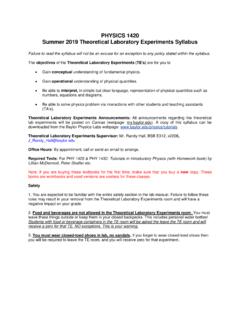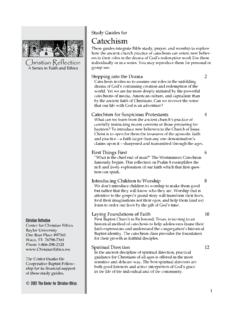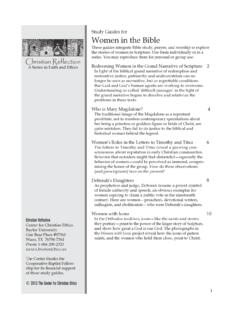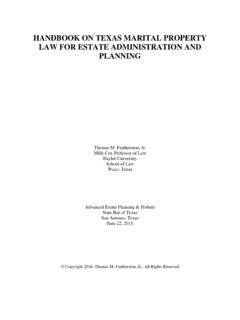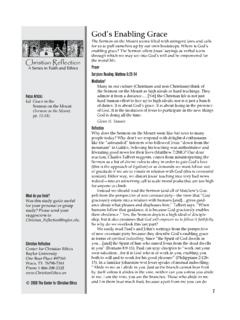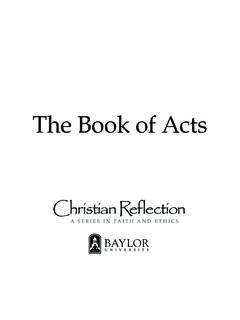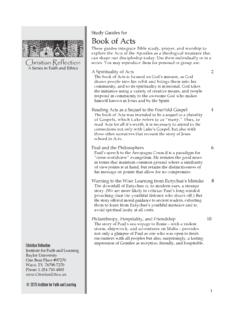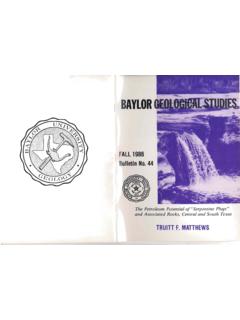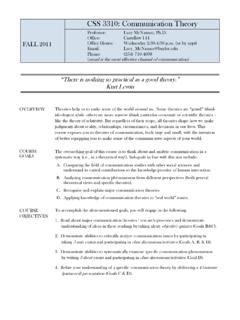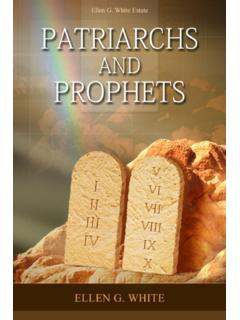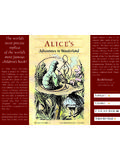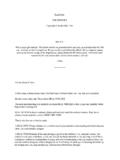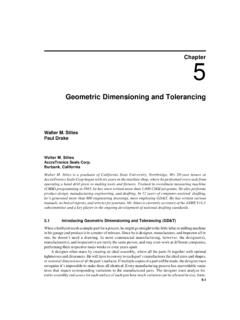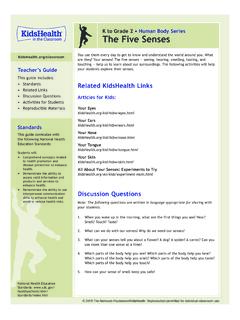Transcription of Distinctive Traditions of Epiphany - Baylor University
1 Copyright 2011 Center for Christian Ethics at Baylor University Distinctive Traditions of EpiphanyBy AmBer And John Inscore essIckThe Epiphany feast completes the season of christmas by inviting us to discern the identity of the christ child. Three Traditions baking a kings cake, marking a door lintel with the magi s blessing, and elaborating worship with lighted candles help us interpret the christmas season celebrate the feast of Epiphany is to continue down the liturgical path that originates in the anticipatory weeks of Advent. The feast completes the season of Christmas by inviting us to discern the identity of the Christ child.
2 Like the Magi who anticipated, recognized, and welcomed the infant king, congregations and families can recognize and proclaim the appearance of God s chosen one. Thus, Epiphany is the culmination of the Christmas season, not its ending. Recovering three historical Epiphany Traditions baking a Kings Cake, marking a door lintel with the Magi s blessing, and elaborating worship with lighted candles can help God s people interpret the Christmas season KINGs CAKeJust as the Magi made a careful search for the child king upon his birth, so we should acknowledge that an important component of our faith involves seeking and searching for the Lord in unlikely places.
3 One delightful way to celebrate Epiphany in the home is to prepare and eat a Kings Cake with friends and family. In this symbolic search for the baby Jesus, children and adults gather to eat a delicious cake or pastry with a toy baby hidden inside. 70 Christmas and Epiphany The person who finds the baby Jesus in his or her piece of cake is awarded the honor of providing the next year s cake and/or hosting the celebration. At an Epiphany celebration a few years ago, we were all surprised to find at least six or seven baby Jesus figures in the cake! While the baker seemed to have misunderstood the directions, everyone found baby Jesus on that day.
4 Kings Cakes are made in many shapes. One tradition involves a wreath-shaped cake, which symbolizes the circuitous route the Magi took to avoid King Herod, who hunted for the Christ child to harm him. Also, in some parts of the world there is a tradition of using a bean instead of a figurine. Many Hispanic bakeries will carry Rosca de Reyes (the Kings Cake) in the days leading up to the feast of Epiphany on January 6. In the Gulf Coast region of the United States there is a similar product, the King Cake, avail-able for Mardi Gras (Fat Tuesday, or Shrove Tuesday), the feast that con-cludes the extended season of Epiphany .
5 Remember when you are shopping for King Cake that the date of Mardi Gras varies each year because it is tied to the lunar calendar, like Easter. If these cakes are not sold in your area, or you prefer to bake your own, many recipes for Rosca de Reyes and New Orleans-style King Cake are available on the Kings Cake tradition is as meaningful as it is enjoyable. Besides the element of searching involved, any time Christians gather around the table it evokes images of the Lord s Supper at which we share in the presence of Christ. Even as the risen Christ was made known to his followers in the breaking of bread, so on Epiphany celebrants discover the incarnate Christ as they break and eat the Kings Cake.
6 There is also an important link be-tween hospitality and the Epiphany : did not the Magi enjoy the hospitality of the Holy Family? Did not King Herod display a considerable lack of hos-pitality when he deceived and exploited his guests? As we give and receive hospitality during Christmas and Epiphany , we participate in the story of the Magi and their search for the Christ child, we celebrate the joy of Jesus appearance, and we find God at a surprisingly familiar place: the table. The MAGI s BLessINGLess frequently mentioned in discussions of hospitality is its reciprocal nature.
7 Often when guests receive a host s welcome and provision, they bless the household who welcomes them. Another tradition of Epiphany invokes the Magi s blessing upon the household that hosts the party. Guests typically read a brief, responsive liturgy that includes the biblical account of the Magi s visit and then chalk the door with a series of markings include letters, numbers, and crosses in a pattern like this: 20 C M B 12. The numbers correspond to the calendar year (20 and 12, for instance, for the year 2012); the crosses stand for Christ; and the letters have a two-fold significance: C, M, and B are the initials for the traditional names of the Magi (Caspar, Melchior, and Balthasar), but they are also an abbreviation of the Latin blessing Christus mansionem benedicat, which means, May Christ bless this house.
8 Distinctive Traditions of Epiphany 71A brief liturgy fit for chalking the lintel can be found at the end of this article. Although the service of chalking the door with the Magi s blessing is intended for an Epiphany celebration in a private family dwelling, you can adapt it for other contexts. At any time during the seasons of Christmas and Epiphany it may be used to bless a room in a hospital, nursing home, or extended-care facility; to inaugurate the spring semester in a college dormi-tory room; to set aside a Bible study meeting place, choir practice room, or youth area at church; and so Magi, who journeyed a great distance to recognize the birth of a foreign king, recognized the blessing of peace that this king s appearance signified.
9 Their gifts and obeisance to the new king implied their acceptance of his peaceful reign. As we reenact the Magi s blessing, we acknowledge that Christ s entrance into the world makes our homes places of peace and hospitality. CANDLeLIGhT ON ePIPhANYFrom Advent wreaths to Christmas Eve candlelight services to symbolic tongues of fire on Pentecost, candlelight is an important metaphor and teach-ing tool for many congregations throughout the liturgical year. In addition to the Kings Cake and Magi s blessing, thoughtful and intentional incorpo-ration of lighted candles in homes and churches can help us reclaim Epipha-ny as a celebration of the arrival of the Magi.
10 The candlelight also reminds us that the feast of Epipha-ny marks the theophany of Christ, the recognition of Christ in his baptism by the Father and Holy to Luke and John, God s appearance in the person of Jesus is com-parable to light entering a darkened world. When Simeon took the Christ child in his arms, he praised God for sending salvation and light to all nations and as a glory to God s people of Israel (Luke 2:32). The prologue of John proclaims that the Word is God s light, already appeared in our midst, though not everyone recognizes its arrival (John 1:4-5).
